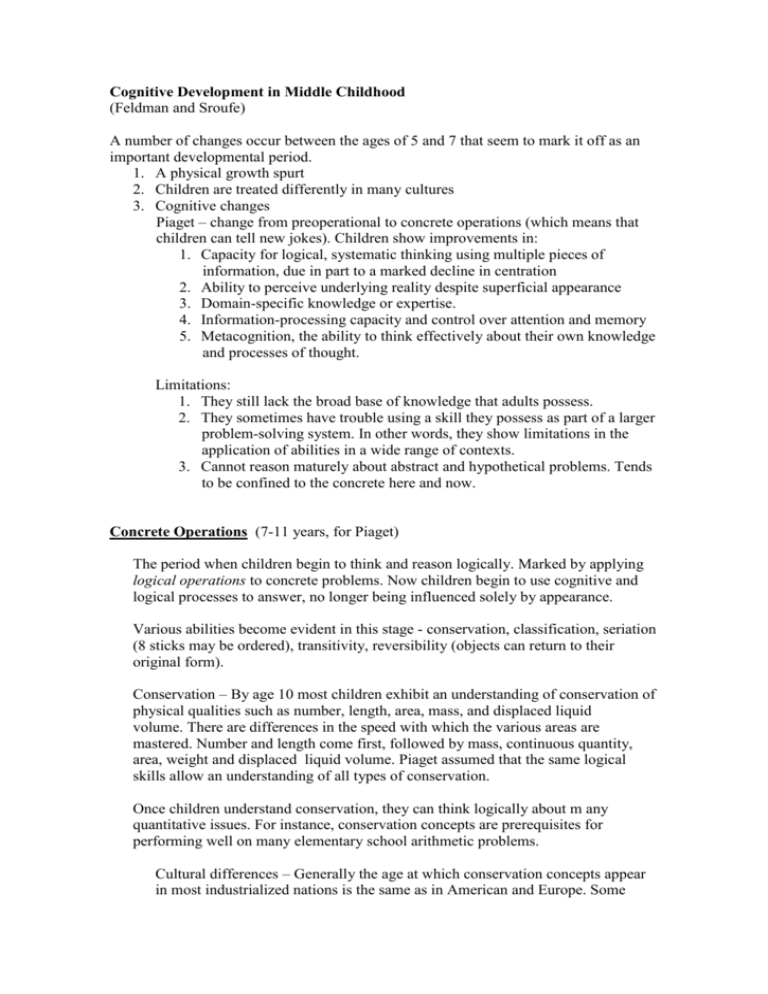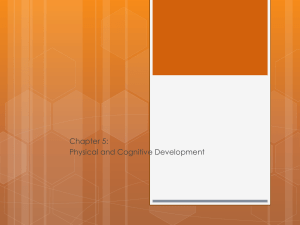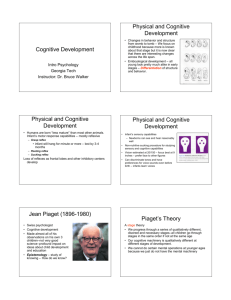Concrete Operations (7
advertisement

Cognitive Development in Middle Childhood (Feldman and Sroufe) A number of changes occur between the ages of 5 and 7 that seem to mark it off as an important developmental period. 1. A physical growth spurt 2. Children are treated differently in many cultures 3. Cognitive changes Piaget – change from preoperational to concrete operations (which means that children can tell new jokes). Children show improvements in: 1. Capacity for logical, systematic thinking using multiple pieces of information, due in part to a marked decline in centration 2. Ability to perceive underlying reality despite superficial appearance 3. Domain-specific knowledge or expertise. 4. Information-processing capacity and control over attention and memory 5. Metacognition, the ability to think effectively about their own knowledge and processes of thought. Limitations: 1. They still lack the broad base of knowledge that adults possess. 2. They sometimes have trouble using a skill they possess as part of a larger problem-solving system. In other words, they show limitations in the application of abilities in a wide range of contexts. 3. Cannot reason maturely about abstract and hypothetical problems. Tends to be confined to the concrete here and now. Concrete Operations (7-11 years, for Piaget) The period when children begin to think and reason logically. Marked by applying logical operations to concrete problems. Now children begin to use cognitive and logical processes to answer, no longer being influenced solely by appearance. Various abilities become evident in this stage - conservation, classification, seriation (8 sticks may be ordered), transitivity, reversibility (objects can return to their original form). Conservation – By age 10 most children exhibit an understanding of conservation of physical qualities such as number, length, area, mass, and displaced liquid volume. There are differences in the speed with which the various areas are mastered. Number and length come first, followed by mass, continuous quantity, area, weight and displaced liquid volume. Piaget assumed that the same logical skills allow an understanding of all types of conservation. Once children understand conservation, they can think logically about m any quantitative issues. For instance, conservation concepts are prerequisites for performing well on many elementary school arithmetic problems. Cultural differences – Generally the age at which conservation concepts appear in most industrialized nations is the same as in American and Europe. Some asian children however seem to understand conservation faster. In traditional cultures lacking formal schooling a lag of one or more years is found. Sometimes adults are found who do not understand these concepts. There are two possible explanations – one is that the researchers are not clearly communicating their intent because of language differences. The other is that kids who lack formal schooling do not have the opportunity to learn the skills. They can now decenter, or take multiple aspects of a situation into account. Their thinking also shows reversibility, which is the notion that processes transforming a stimulus can be reversed, returning it to its original form. A ball of clay can be rolled back into a ball, and if 3+5=8, then 5+3=8, and later that 8-5=3. They can also understand such concepts as the relationship between time, speed, and distance, e.g. that an increase in speed can compensate for greater distance in a journey. This is not a sudden change…during the previous two years children have been shifting back and forth between preoperational and concrete operational thinking (horizontal decalage). Also pass through a period in which they can answer conservation and other problems correctly but can’t say why. Organizes events by means of logical-mathematical structures. Uses numbers and measurements. Logical thinking marked by the manipulation of concrete objects. Still no notion of hypothesis or propositions. Thinking becomes more differentiated and children come to appreciate the value of rules. Cannot yet think very abstractly, analyze their own thoughts, or consider problems in the future. Sometimes we refer to this distinction as one between contingent truth (based on observation with the senses) and necessary truth (logical deduction). For example, they have difficulty with hypothetical, non-concrete propositions: If all Martians have yellow feet and this creature has yellow feet, is it a Martian? What we see is a movement towards greater abstraction – that is, reasoning that is done on its own merits without direct reference to a concrete situation, and en extension of its range of applicability. Qualifications Piaget underestimated children’s capabilities. More variation in children’s abilities is obtained by modifying the experimental situation. Capabilities emerge earlier than he expected. Cross-cultural research suggests that some children never leave the pre-operational stage. For example. Patricia Greenfield found that with the Wolof children in Senegal (W. Africa) only about half of 10-13 year olds understood conservation of liquid. Confirmed in the jungles of New Guinea, Brazil and Australia. However, training is possible, and children perform better when researchers from their own culture, who use reasoning tasks that are related to domains important to the culture. Ability to perform concrete operations depends on developmental experience. Memory Improvements Short-term memory improves significantly. For example, they are increasingly able to hear a string of digits and repeat it in reverse order. At beginning of preschool they can only do this with two digits, by beginning of adolescence they can do this with up to 6 digits. Can also use more sophisticated strategies for recalling information, which can be improved with training. Could the inability to conserve in preoperational stage be due to memory limitations? Metamemory, an understanding about the proceses that underlie memory, also improves during middle childhood. By the time they enter first grade and their theory of mind becomes more sophisticated, children have a general notion of what memory is, and they are able to understand that some people have better memories than others. Understanding of memory becomes more sophisticated as they grow older and increasingly engage in control strategies –conscious, intentionally used tactics to improve cognitive processing. School-age children are aware that rehearsal is a useful strategy. Also make progressively more effort to organize material into coherent patterns for better recall. Improving memory Yes, can be taught particular strategies, but it is not simple. They have to know not only how to use a memory strategy but also when and where to use it most effectively. Key-word strategy – foreign language – pair a Spanish word with an English word – pato and pot and then link the two with a visual image. Also may relate words with imagery – cognitive elaboration Techniques – rehearsal, organization (placing material into categories), keyword, cognitive elaboration Vygotsky’s Approach to Cognitive Development and Classroom Instruction Cognitive advances occur through exposure to information within a child’s zone of proximal development. The ZPD is the level at which a child can almost, but not quite, understand or perform a task unassisted. Also promoted the idea that children should actively participate in their educational experiences, so children should be given opportunities to experiment and try out new activities. This is consistent with Dewey’s ideas about progressive education. Education should focus on activities that involve interaction with others. Both child-adult and child-child interactions can provide the potential for cognitive growth. The nature of the interactions must be carefully structured to fall within each individual child’s ZPD. Classroom techniques: Cooperative learning – children work together in groups to achieve a common goal. Benefits from the insights of others, and brought back on course by others (not every child will benefit equally – depending on the character of the task some might be more competent than others). Reciprocal teaching – a technique to teach reading comprehension strategies. Students are taught to skim the content of a passage, raise questions about its central point, summarize the passage, and finally predict what will happen next. In the beginning, teachers lead students through the comprehension strategies. Gradually, students progress through their ZPDs, taking more and more control over use of the strategies, until the students are able to take on a teaching role. Has impressive success, especially for children with reading difficulties. Language Development Mastering the mechanics of language: Vocabulary increases in school years. 6 year old – 8,000 to 14,000 words. Grows by another 5,000 from 9-11. Mastery of grammar also improves – increasing use of passive voice and conditionals. Phonemes – first graders may still have difficulty pronouncing j, v, th, and zh sounds. Improves. Intonation – increase in ability to distinguish meaning based on tone. Pragmatics – parallel conversations become more give and take. Metalinguistic Awareness An increasing understanding of one’s own use of language. By 5 or 6, children understand that we can abstract rules from language. Understanding becomes more explicit in middle childhood. Helps children achieve comprehension wheninformation is fuzzy or incomplete. Preschoolers rarely ask for clarification when being given directions, and blame themselves if they do not understand. By7 or 8, they understand that miscommunication by themselves or other can occur, and are more likely to ask for clarification. How Language Promotes Self-Control “Self-talk” is now used to regulate behavior. See the marshmallow experiment. Also, see Vygotsky’s ideas of external and internal speech as self-regulation. Also Dewey’s idea of ability to control impulse and develop purpose. Bilingualism Nearly one in 5 people in the U.S. speaks a language other than English at home. Knowing more than one language has clear cognitive advantages. Speakers have a wider range of linguistic possibilities to choose from and so have greater cognitive flexibility. Can solve problems with greater creativity and versatility. Learning in one’s native tongue leads to higher self-esteem in minority students. Bilinguals often have greater metalinguistic awareness. May even score higher on tests of intelligence, according to some research. Second language learning should be a regular part of elementary schooling for all children. Schooling: The Three R’s of Middle Childhood Schooling around the world In U.S. virtually all children are provided with a free education through the 12th grade. More than 160 million of the world’s children do not have access to even a p rimary school education. An additional 100 million do not progress beyond a level comparable to our elementary school education, and close to a billion individuals (two thirds of them women) are illiterate throughout their lives. In almost all developing countries fewer females than males receive formal education. What makes children ready for school? Should younger children wait to be placed in school? Research suggests that the younger children in a class progress at the same rate as the oldest. Parents who hold their children back in Kindergarten are not doing them a favour. Other research suggests that while delays do not matter in elementary school, that adolescents who were held back show a surprising number with emotional and behavioral problems. The start of school should be tied to overall developmental readiness. Some of the factors that predict success are: 1. 2. 3. 4. 5. 6. 7. 8. Print familiarity – Knowing the alphabet Higher level of parental educational attainment The family owning a lot of books Having a computer in the home Watching less T.V. Taken to museums, participation in dance, art, music, or crafts classes. Living in a stable home (no more than 2 moves). Reading: Learning to Decode the Meaning Behind Words Development of reading skills occurs in several broad and frequently overlapping stages. 1. birth to start of first grade - children start to learn the essential prerequisites for reading – including identification of letters of the alphabet, sometimes writing their names, and reading a few very familiar words, such as their own names or “stop”. 2. Stage 1 – First and second grades - the first real type of reading, but largely involving phonological recoding skill. Children can sound out words by blending the letters together. Also complete the job of learning the names of letters and the sounds that go with them. 3. Stage 2 – second and third grades – learn to read aloud with fluency. Often do not attach much meaning to the words because the effort involved in simply sounding out words is usually so great that relatively few cognitive resources are left over to process the meaning of the words. 4. Stage 3 – fourth through eighth grades – reading becomes a means to an end – in particular, a way to learn. Earlier reading is an accomplishment in and of itself. Understanding not complete. One limitation is that they are able to comprehend information only when it is presented from a single perspective. 5. Stage 4 – able to read and process information that reflects multiple points of view. Permits a far more sophisticated understanding of material. How should we teach reading? Much debate about the most effective means of teaching reading. At the heart of the debate is a disagreement about the nature of the mechanisms by which information is processed during reading. Code-based approaches – Reading should be taught by presenting the a basic skills that underlie reading. Emphasize the components of reading, such as the sounds of letters and their combination – phonics – and how letters and sounds are combined to make words. Reading consists of processing the individual components of words, combining them into words, and then using the words to derive the meaning of written sentences and passages. Whole language approach – reading is viewed as a natural process, similar to the acquisition of oral language. Children should learn to read through exposure to complete writing – sentences, stories, poems, lists, charts, and other examples of actual uses of writing. Instead of being taught to sound out words, children are encouraged to make guesses about the meaning of words based on the context in which they appear. Through such a trial-and-error approach, children come to learn whole words and phrases at a time, gradually becoming proficient readers. Whole language approach – has less support from research and so is being dropped. Educational Trends Beyond the Three R’s U.S. schools are experiencing a return to the educational fundamentals embodied in the traditional three R’s. Last few decades have focused on the child’s social well-being and on allowing students to choose study topics on the basis of their interests instead of following a set curriculum. Elementary school classrooms also stress individual accountability, both for teachers and for students. Teachers are more likely to be held responsible for their students’ learning and both teachers and students are more likely to be required to take tests, developed at the state or national level, to assess their competence. U.S. schools have also p aid increased attention to issues involving student diversity and multiculturalism. Cultural, as well as language difference affect students socially and educationally. Multicultural Education Education is often seen as providing a formal mechanism to transmit the information a society deems important. So in a multicultural classroom what society are we educating students for? For a U.S. society? A “democratic” society? A global society? A British society? The school context society? Student’s cultural backgrounds have a substantial impact on the way that they, and their peers – are educated. Does a “multicultural” education apply to our teaching contexts? Helping students become enculturated in the dominant culture while maintaining positive group identities that build on their original cultures. Do we promote a “cultural assimilation model” or a “pluralistic society model?” Shouldn’t our kids learn about their cultural heritage? Fostering a bicultural identity – Schools should encourage children to maintain their original cultural identities while they integrate themselves into the dominant culture. The idea is that an individual can live as a member of two cultures, with two cultural identities, without having to choose one over the other. Should Schools Teach Emotional Intelligence? The set of skills that underlie the accurate assessment, evaluation, expression,and regulation of emotions. David Goleman. Lessons in empathy,self-awareness, and social skills, caring and friendship. Some think that emotional literacy should be taught as a standard part of the curriculum. That would mean programs to help children manage their emotions more effectively. Critics argue that this is best left to others (like families). Also, there is no clear set of well-specified criteria for what constitutes emotional intelligence. Expectation Effects: How Teachers’ Expectancies Influence Their Students Teachers do treat children differently when they have expectations of improvement vs. from those for whom they have no such expectations. This is a hooray for the teachers, because the children were assessed on an intelligence test that was identical at the beginning of the year and at the end. So the I.Q. test score went up more for those kids the teachers thought would “bloom” this year. The teacher expectancy effect – the cycle of behavior in which a teacher transmits an expectation about a child and thereby actually brings about the expected behavior. Similar to the self-fulfilling prophecy effect, or the effect of placebos.








